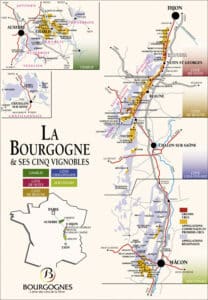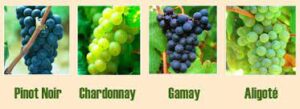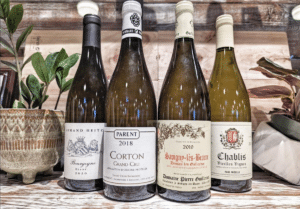Discover Burgundy with Mr. B’s
Greetings and welcome to Mr. B’s new and exclusive Discover series. Each month we’ll explore different wine regions, styles, and so much more. Our adventure begins in France with one of the most prestigious wine-producing regions in the world: Burgundy.
Welcome to Burgundy
Located in eastern France, Burgundy is both one of the country’s oldest wine-producing regions and one of the most esteemed. With a history stretching back to as early as 50 BC when the Romans brought viticulture to the region, these wines have gone through meticulous development as generations of vignerons honed their craft.
We have Cistercian monks to thank for many of the advances in Burgundian winemaking. They were the ones who initially found that grapes cultivated in different areas produced wines that differed noticeably in quality and flavor. This discovery led to the idea of “terroir,” a term that refers to how the attributes of an area- such as climate, soil type, and sun exposure- affect the character of a wine.
Today, Burgundy is still considered a heavily terroir-driven region with different vineyards, even ones that are close to each other, producing distinct wines. Because of this, Burgundy is broken down into several sub-regions, each with its own qualities and characteristics. Let’s take a look at those to start.
Regions Of Burgundy
Image via grapesandcorks.com
Chablis– Far to the north of the rest of Burgundy, Chablis exclusively produces Chardonnay. These wines are generally unoaked and err away from big buttery flavors in favor of leaner, more acidic, and mineral-driven profiles. Unlike the rest of Burgundy, Chablis has its own system of appellations. From least to most prestigious, these are Petit Chablis, Chablis, Premier Cru Chablis, and Grand Cru Chablis. It’s worth noting that, unlike the rest of this region, some Premier Cru and all Grand Cru wines spend some time in oak barrels which makes them rich, decadent, and oh-so good.
Côte d’Or– With a name meaning “Golden Slope,” it’s no surprise that this region is often considered to be the most prestigious. Côte d’Or breaks down into two subsections: Côte de Beaune and Côte de Nuit. While Côte de Beaune produces primarily white wines of exquisite quality, Côte de Nuit does the same with reds. Want to try something special? Look for a Chardonnay from Meursault or a Pinot Noir from Nuits-Saint-Georges.
Côte Chalonnaise– South of Côte d’Or lies Chalonnaise. This region produces mostly light, fresh, and fruity reds, although several floral and citrusy whites are made here as well.
Mâconnais– While Mâconnais largely makes white wine from Chardonnay, and some from Aligoté, its reds are made almost exclusively from Gamay. This is a great region to explore to get a sense of Burgundian character with a twist.
Burgundy further breaks down its regions into more finely defined areas as defined by its system of appellations. Knowing a bit about these will be a tremendous help in your journey through its wines and even act as a general guide to reading the labels and choosing a bottle that’s right for you. Broadly speaking, here’s how they work.
Appellations
Regional– The most basic of Burgundian wines. These labels can read as generically as “Bourgogne Rouge” or “Bourgogne Blanc.” These can be made from grapes that are sourced from across Burgundy and act as excellent entry points for people who are curious about its wines but don’t want to spend a small fortune.
Villages– A step up from the regional wines, the labels of these will tell you which area of Burgundy they are from and can give you a better sense of the terroir. Curious? Look for labels that say things like “Mercurey,” “Pouilly-Fuissé,” or “Beaune.” These, of course, are just a few. There are fifty-three villages throughout Burgundy that can put their name on a bottle to claim it as their own. There is a lot to explore.
Premier Cru– The second-highest designation for wine from Burgundy. The quality of these wines are generally quite good and can fetch a high price. Now we’re starting to get into the fine lines of terroir. A wine label from one of these micro-areas will say the name of the village followed by either “Premier Cru” or “1er Cru.”
Grand Cru– The best of the best, often with a price tag to match. These wines occupy the best plots of land and yield the highest quality grapes. Bottles of these will most frequently show the vineyard name, then the term “Grand Cru.” For example: “Domaine Méo-Camuzet Grand Cru Échezeaux les Rouges du Bas.”
Knowing the regions, sub-regions, and appellations of Burgundy is a fantastic start in getting to know its wines, but what about the grapes themselves? There are four major varietals grown here. Let’s make their acquaintance.
Key Varietals
image via burgundydiscovery.com
Chardonnay– The most widely planted varietal in Burgundy, Chardonnay from this region can change expression dramatically depending on where it’s grown and how it’s treated. Many examples are lean and driven by bright acidity and pronounced minerality. Others see some oak treatment, although this is less common than in the Chardonnay grown stateside. Wines made in this manner can take on rich flavors and creamy textures. Chardonnay lends itself well to expressing terroir, so a wine produced in one area may taste noticeably different from another harvested from mere plots away.
Pinot Noir– Pinot Noir is the most cultivated red varietal in Burgundy and the most sought-after amongst collectors. Younger wines of this sort are known for bright red fruit tones, while lots of umami, and earthy, mushroomy, flavors come with age. Generally, Burgundian Pinot Noirs have low to medium tannins and are among the most food-friendly wines.
Aligoté– Making up less than 10% of total wine production in Burgundy, Aligoté is a grape no less worthy of consideration. These white wines are desert dry and refreshing with appley, floral, citrusy notes and high acidity. Try one of these the next time you have grilled fish or roast chicken.
Gamay– Maligned as “vile and disloyal” by Duke Philip the Bold in 1395, Gamay has become a beloved grape, especially in Beaujolais, but that’s a story for another time. Today, Gamay accounts for about 2% of all wine produced in Burgundy and is mainly enjoyed in younger, fruitier iterations.
Wines We LOVE!
| There’s a lot to love about Burgundy. Each bottle has its own character and with such a diverse range of profiles, there’s a wine for every palate. Come on by and let us help you find your new favorite. Santé! |
Written by: Marshall Davidson





